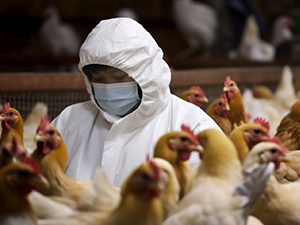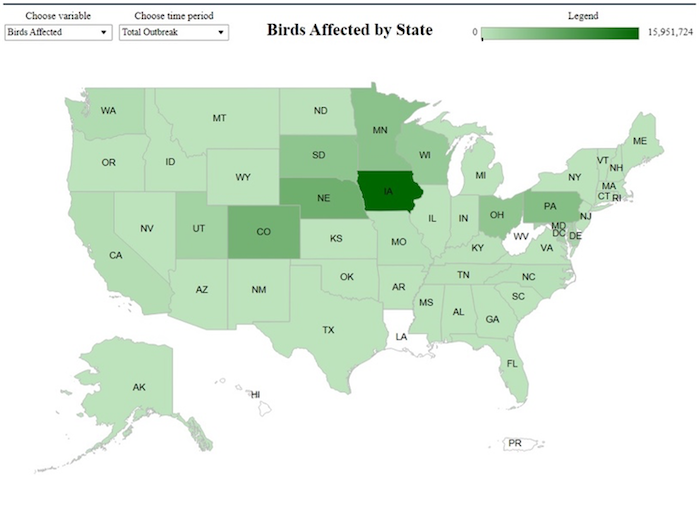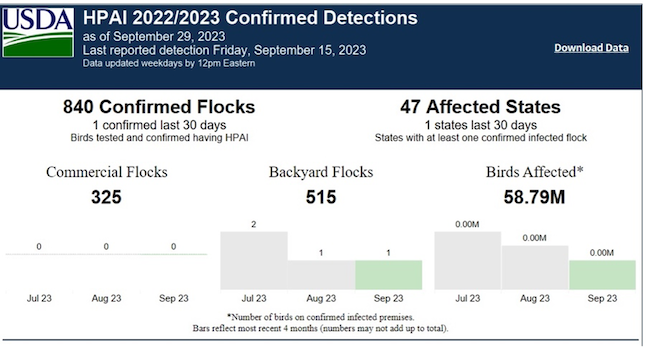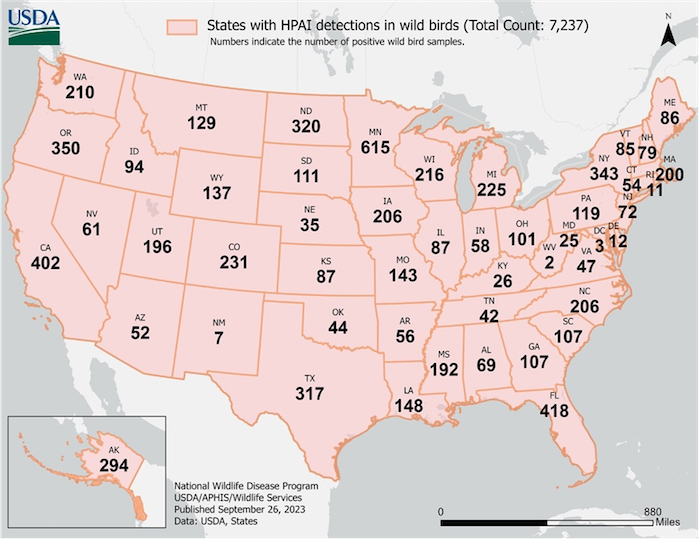Fall 2023 Avian Flu Report
Oct 10, 2023
The current strain of H5N1 Highly Pathogenic Avian Influenza (HPAI) has upended the global poultry industry – and resulted in the deadliest bird flu outbreak in history. Since the flu arrived in the United States in early 2022, poultry farmers and wildlife conservationists have scrambled to contain cases.
A lucky turn of events in the spring and summer aided their effort. The extreme heat that’s blanketed the nation over the past months, combined with a nationwide increase in poultry biosecurity measures, slowed the domestic spread of this deadly bird disease down to a trickle.
But, while infections have subsided in the U.S., new outbreaks have been reported globally in the last few months. With winter and flu season on the horizon, we cannot let our guard down just yet.
New Cases in Domestic Flocks Declining


Avian flu has been found in commercial or backyard flocks in nearly every U.S. state since the beginning of the outbreak, with only 3 states not reporting domestic flock cases: Louisiana, West Virginia, and Hawaii. Since the start of the outbreak, tens of millions of birds have died.
In the past 30 days, new commercial and backyard flock cases of the flu have only been found in three states: South Dakota, Idaho, and New Jersey.
As cases decline, egg prices – which were up 267% at the peak of the outbreak – have started to plateau. Farmers, however, are still suffering as they try to recoup their losses and continue to protect their flocks without losing profit.
To help maintain the low levels of new infections, last week USDA APHIS enacted restrictions on importing poultry from European countries still experiencing high levels of cases and poultry deaths.
Wild Birds Cases Remain Relatively Fixed

Wild bird cases have been found in all 50 states and mass mortality events are still occurring.
Birds of prey, like eagles, owls, and vultures seem to be particularly hard hit, with wildlife rehabilitation facilities saying avian flu cases account for a high percent of their bird intake. Most birds are admitted with neurological symptoms and few recover.
Waterfowl seem to be slightly less susceptible to the disease, but mortality is still occurring among species that were resistant to previous flu outbreaks. To complicate matters, many of these species are known to harbor the disease but are asymptomatic.
As of the end of September, over 7,000 cases have been detected in wild bird populations. While that number may seems small compared to domestic flocks, it’s important to understand that very few birds are actually tested for HPAI. In a mass mortality event where thousands of birds have died, only a handful have been tested and added to the statistics.
Avian Flu in Mammals Continue to be Detected
Unfortunately, birds are not the only animals affected by the outbreak. Mammals are falling ill and dying from avian flu as well.
Most infected mammals – including coyotes, foxes, bobcats, skunks, raccoons, otters, bears, and seals – exhibit neurological symptoms before succumbing or being put down. Notably, dozens of domestic housecats in Poland died this summer from HPAI. Mink fur farms also continue to be hit hard. These cases likely originated after the animals consumed infected birds.
Recommendations
While it is likely that some pets have already been infected, small animal pet veterinarians are not testing for avian flu, so data is currently unavailable. To keep pets safe, avoid feeding them raw poultry products and prevent them from ingesting any wild birds.
At this time, only one human case of H5N1 has been reported in the U.S. The patient sanitized an infected domestic flock and presented very mild symptoms. While the risk of contracting avian flu is low, practicing good cooking and hygiene techniques greatly reduces the risk of infection.
Keep Flocks Safe with Wild Goose Chase Indy
The Wild Goose Chase Indy team is closely monitoring this ongoing situation.
Since the previous HPAI outbreak in 2014-2015, our team has provided biosecurity solutions to poultry farmers to help keep their flocks safe. While solutions vary based on circumstances and needs, autonomic laser systems have effectively protected domestic flocks from wild ones, by keeping wild birds out of feeding and watering areas where contamination can occur.
To learn more about how Wild Goose Chase Indy can protect your flock, or to schedule a site evaluation, contact us.


 0
0
